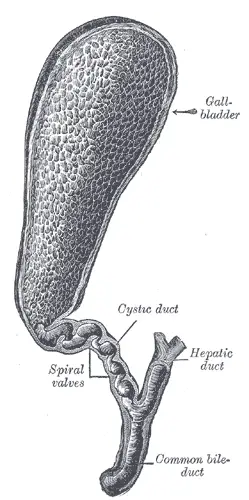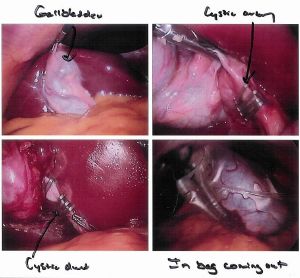Difference between revisions of "Gallbladder" - New World Encyclopedia
Jyoti Sharma (talk | contribs) |
Jyoti Sharma (talk | contribs) |
||
| Line 15: | Line 15: | ||
==Function== | ==Function== | ||
| − | The gallbladder stores and concentrates [[bile]], which is released from the gallbladder after a signal from | + | The gallbladder stores and concentrates [[bile]], which is released from the gallbladder after a signal from CCK, which is released from the duodenum. When food containing [[fat]] enters the [[digestive tract]], the secretion of [[CCK]] is stimulated. CCK in turn produces forceful contractions of the gallbladder, larger amounts of hepatic secretion of [[bile]], enhanced flow of [[bile]] into the duodenum, and less resistance of the sphincter of Oddi (Wilson 1991). The sphincter of Oddi serves to keep bile from entering the digestive tract during times of fasting through continuous contraction. |
| − | [[Bile]] emulsifies | + | [[Bile]] emulsifies fats and neutralizes acids in the partly digested food present in the digestive tract. Bile, which is originally made in the [[liver]], becomes more concentrated than when it left the liver, increasing its potency and intensifying its effect on fats. |
==Role in Disease== | ==Role in Disease== | ||
Revision as of 22:04, 2 June 2006
The gallbladder, or cholecyst, is a pear-shaped organ that stores and concentrates between 30 to 75 mL of bile until it is needed to aid with fat digestion. In humans, the gallbladder is about 7 to 10 cm long and is dark green in appearance due to its contents (bile). It is not a necessary organ for survival in humans.
Not all mammals have gallbladders. The rat, pigeon, and horse, for example, do not have a specialized organ for the storage of bile. In general, omnivores that eat animal flesh have gallbladders.
Anatomy
The gallbladder has an epithelial lining characterised by recesses called Aschoff's recesses, which are pouches inside the lining. Under the epithelium is a layer of connective tissue, followed by a muscular wall that contracts in response to cholecystokinin, or CCK, a peptide hormone secreted by the duodenum.
The cystic duct, which serves as the entrance and exit to the gallbladder, joins the liver's hepatic duct to form the common bile duct. Bile enters the duodenum through the common bile duct. The duodenum, which is the first part of the small intestine, is where most of digestion takes place. Blood is supplied to the gallbladder by the cystic artery, which runs parallel to the cystic duct. The cystic artery is highly variable, which is of clinical relevance since it is cut and clipped during a cholecystectomy.
The surface marking of the gallbladder is the intersection of the mid-clavicular line, or MCL, and the transpyloric plane at the tip of the ninth rib.
Function
The gallbladder stores and concentrates bile, which is released from the gallbladder after a signal from CCK, which is released from the duodenum. When food containing fat enters the digestive tract, the secretion of CCK is stimulated. CCK in turn produces forceful contractions of the gallbladder, larger amounts of hepatic secretion of bile, enhanced flow of bile into the duodenum, and less resistance of the sphincter of Oddi (Wilson 1991). The sphincter of Oddi serves to keep bile from entering the digestive tract during times of fasting through continuous contraction.
Bile emulsifies fats and neutralizes acids in the partly digested food present in the digestive tract. Bile, which is originally made in the liver, becomes more concentrated than when it left the liver, increasing its potency and intensifying its effect on fats.
Role in Disease
Cholestasis
Cholestasis is the blockage in the supply of bile into the digestive tract. It can be "intrahepatic" (the obstruction is in the liver) or "extrahepatic" (outside the liver). It can lead to jaundice, and is identified by the presence of elevated bilirubin level that is mainly conjugated.
Cholelithiasis
Up to 25% of all people have gallstones (cholelithiasis), composed of cholesterol, lecithin and bile acids. These can cause colicky shooting abdominal pain, usually in relation with the meal, as the gallbladder contracts and gallstones pass through the bile duct. Surgery (cholecystectomy, removal of the gallbladder) is the most common treatment for gallstones. It can be performed laparoscopically, and it is in fact one of the most common procedures done through the laparoscope.
People traditionally considered at an increased risk of cholelithiasis are people who are 5 F's:
- Female
- Fat (obesity)
- Fair (Caucasian, but this is disputed by recent studies)
- Forty (middle-aged)
- Fertile (the risk is increased in pregnancy)
Cholecystitis
- Please refer to main article: Cholecystitis
Acute or chronic inflammation of the gall bladder causes abdominal pain. 90% of cases of acute cholecystitis are caused by the presence of gallstones. The actual inflammation is due to secondary infection with bacteria of an obstructed gallbladder, with the obstruction caused by the gallstones.
Choledocholithiasis
Please refer to main article: Choledocholithiasis
When gallstones obstruct the common bile duct, the patient develops jaundice and liver cell damage. It is a medical emergency, requiring endoscopic or surgical treatment.
Gallstone ileus
A rare clinical entity is ileus (bowel obstruction) by a large gallstone, or gallstone ileus. This condition develops in patients with longstanding gallstone disease, in which the gallbladder forms a fistula with the digestive tract. Large stones pass into the bowel, and generally block the gut at the level of Treitz' ligament or the ileocecal valve, two narrow points in the digestive tract. The treatment is surgical.
Gallbladder Cancer
Cancer of the Gallbladder is a rare but highly fatal disease. It has been associated with gallstone disease, estrogens, cigarette smoking, alcohol consumption, obesity, and female sex. Despite aggressive modern surgical approaches, advanced imaging techniques, and endoscopy, nearly 90% of patients will present with and die from advanced disease, experiencing pain, jaundice, weight loss, and ascites prior to their demise.
Israel has the highest incidence worldwide, with 7.5 cases per 100,000 men and 13.8 cases per 100,000 women. Other countries with significant incidence rates include Mexico, Bolivia, Chile, and northern Japan. Low rates are observed in India, Nigeria, and Singapore.
Gallbladder Polyps and Primary Scerlosing Cholangitis
Polyps (growths) are sometimes detected during diagnostic tests for gallbladder disease. Small gallbladder polyps (up to 10 mm) pose little or no risk, but large ones (greater than 15 mm) pose some risk for cancer, so the gallbladder should be removed. Patients with polyps 10 mm to 15 mm have a lower risk but they should still discuss removal of their gallbladder with their physician. Of special note is a condition called primary sclerosing cholangitis, which causes inflammation and scarring in the bile duct. It is associated with a lifetime risk of 7% to 12% for gallbladder cancer. The cause is unknown, although primary sclerosing cholangitis tends to strike younger men who have ulcerative colitis. Polyps are often detected in this condition and have a very high likelihood of malignancy.
External links
| Digestive system - edit |
|---|
| Mouth | Pharynx | Esophagus | Stomach | Pancreas | Gallbladder | Liver | Small intestine (duodenum, jejunum, ileum) | Colon | Cecum | Rectum | Anus |
Credits
New World Encyclopedia writers and editors rewrote and completed the Wikipedia article in accordance with New World Encyclopedia standards. This article abides by terms of the Creative Commons CC-by-sa 3.0 License (CC-by-sa), which may be used and disseminated with proper attribution. Credit is due under the terms of this license that can reference both the New World Encyclopedia contributors and the selfless volunteer contributors of the Wikimedia Foundation. To cite this article click here for a list of acceptable citing formats.The history of earlier contributions by wikipedians is accessible to researchers here:
The history of this article since it was imported to New World Encyclopedia:
Note: Some restrictions may apply to use of individual images which are separately licensed.

